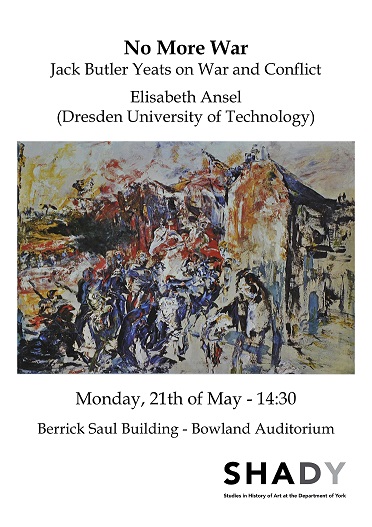No More War: Jack Butler Yeats on War and Conflict
Monday 21 May 2018, 2.30PM
Speaker(s): Elisabeth Ansel (Technical University, Dresden, MA)
In 1951, Irish artist Jack B. Yeats (1871–1957) made his famous anti-war painting 'Grief'. It shows fighting soldiers in the middle of an Irish country town guided by a fierce leader who appears on a white horse similar to the first horseman of the apocalypse. In the foreground a woman and a little boy protect themselves from the violence. A sketch entitled 'Let there be no more war', which Yeats made in his last workbook, seems to have provided an initial thought for the final painting. Both the title of the sketch and the bloody scene of the painting reveal the artist's abhorrence of violence and conflict. The fact that Yeats placed the scene in a town in the west of Ireland, perhaps Sligo, where he spent his childhood and which he once called his ‘spiritual home always’, can further reinforce the impression of the artist’s personal reaction to horror and mourning.
a white horse similar to the first horseman of the apocalypse. In the foreground a woman and a little boy protect themselves from the violence. A sketch entitled 'Let there be no more war', which Yeats made in his last workbook, seems to have provided an initial thought for the final painting. Both the title of the sketch and the bloody scene of the painting reveal the artist's abhorrence of violence and conflict. The fact that Yeats placed the scene in a town in the west of Ireland, perhaps Sligo, where he spent his childhood and which he once called his ‘spiritual home always’, can further reinforce the impression of the artist’s personal reaction to horror and mourning.
In this lecture, Elisabeth Ansel discusses 'Grief' to outline its historical and art-historical contexts. The focus lies on pictures the artist created during and after the Second World War, such as 'Tinkers’ Encampment: The Blood of Abel' (1940) or 'Humanity’s Alibi' (1947). How Yeats reflected on the events of war in his work is of particular interest. To answer this question, Ansel will investigate both literary and pictorial sources. Further, she will look at how other contemporary European artists, such as Picasso and Bacon, visualised the horrors of war and examine the iconographical differences and similarities. Ultimately, she will aim to determine how 'Grief' serves as an anti-war symbol in Jack B. Yeats’s work and discover how Yeats had developed a visual language that is at once highly personal and deeply universal by linking anti-war protest directly to his work.
Location: BS/005 Berrick Saul Building
